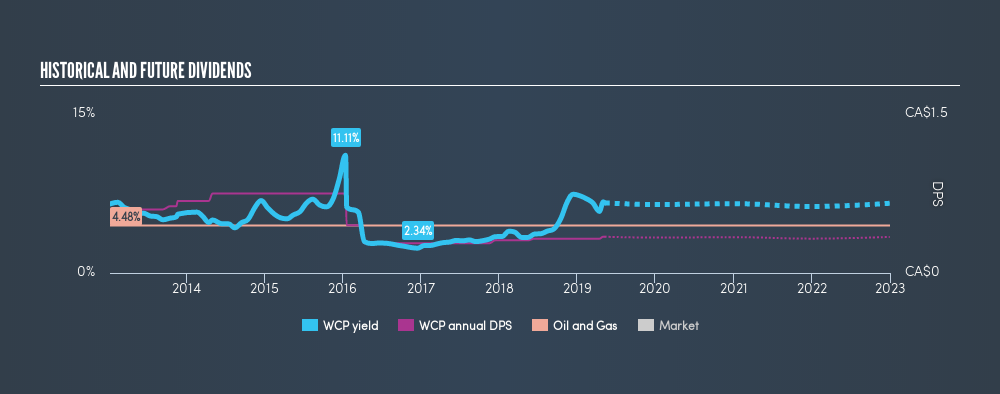
Want to participate in a short research study? Help shape the future of investing tools and you could win a $250 gift card!
Is Whitecap Resources Inc. (TSE:WCP) a good dividend stock? How would you know? Dividend paying companies with growing earnings can be highly rewarding in the long term. Yet sometimes, investors buy a popular dividend stock because of its yield, and then lose money if the company's dividend doesn't live up to expectations.
In this case, Whitecap Resources likely looks attractive to dividend investors, given its 6.6% dividend yield and six-year payment history. It sure looks interesting on these metrics - but there's always more to the story . The company also bought back stock equivalent to around 1.5% of market capitalisation this year. When buying stocks for their dividends, you should always run through the checks below, to see if the dividend looks sustainable.
Explore this interactive chart for our latest analysis on Whitecap Resources!
Payout ratios
Dividends are usually paid out of company earnings. If a company is paying more than it earns, then the dividend might become unsustainable - hardly an ideal situation. As a result, we should always investigate whether a company can afford its dividend, measured as a percentage of a company's net income after tax. Whitecap Resources paid out 652% of its profit as dividends, over the trailing twelve month period. Unless there are extenuating circumstances, from the perspective of an investor who hopes to own the company for many years, a payout ratio of above 100% is definitely a concern.
We also measure dividends paid against a company's levered free cash flow, to see if enough cash was generated to cover the dividend. Whitecap Resources paid out a conservative 46% of its free cash flow as dividends last year.
We think shareholders should look closer into how Whitecap Resources's 652% payout ratio came to be.
Is Whitecap Resources's Balance Sheet Risky?
As Whitecap Resources's dividend was not well covered by earnings, we need to check its balance sheet for signs of financial distress. A rough way to check this is with these two simple ratios: a) net debt divided by EBITDA (earnings before interest, tax, depreciation and amortisation), and b) net interest cover. Net debt to EBITDA measures a company's total debt load relative to its earnings (lower = less debt), while net interest cover measures the company's ability to pay the interest on its debt (higher = greater ability to pay interest costs). Whitecap Resources has net debt of 1.64 times its earnings before interest, tax, depreciation and amortisation (EBITDA), which is generally seen as an acceptable level of debt.
Net interest cover can be calculated by dividing earnings before interest and tax (EBIT) by the company's net interest expense. With EBIT of 1.74 times its interest expense, Whitecap Resources's interest cover is starting to look a bit thin.
Remember, you can always get a snapshot of Whitecap Resources's latest financial position, by checking our visualisation of its financial health.
Dividend Volatility
Before buying a stock for its income, we want to see if the dividends have been stable in the past, and if the company has a track record of maintaining its dividend. Whitecap Resources has been paying a dividend for the past six years. The company has been paying a stable dividend for a while now, which is great. However we'd prefer to see consistency for a few more years before giving it our full seal of approval. During the past six-year period, the first annual payment was CA$0.60 in 2013, compared to CA$0.34 last year. The dividend has shrunk at around -8.9% a year during that period.
Dividend Growth Potential
Examining whether the dividend is affordable and stable is important. However, it's also important to assess if earnings per share (EPS) are growing. Growing EPS can help maintain or increase the purchasing power of the dividend over the long run. Over the past five years, it looks as though Whitecap Resources's EPS have declined at around 29% a year. Declining earnings per share over a number of years is not a great sign for the dividend investor. Without some improvement, this does not bode well for the long term value of a company's dividend.
Conclusion
To summarise, shareholders should always check that Whitecap Resources's dividends are affordable, that its dividend payments are relatively stable, and that it has decent prospects for growing its earnings and dividend. We're not keen on the fact that Whitecap Resources paid out such a high percentage of its income, although its cashflow is in better shape. Earnings per share have been falling, and the company has a relatively short dividend history - shorter than we like, anyway. With this information in mind, we think Whitecap Resources may not be an ideal dividend stock.
Without at least some growth in earnings per share over time, the dividend will eventually come under pressure either from costs or inflation. Very few businesses see earnings consistently shrink year after year in perpetuity though, and so it might be worth seeing what the 5 analysts we track are forecasting for the future.
If you are a dividend investor, you might also want to look at our curated list of dividend stocks yielding above 3%.
We aim to bring you long-term focused research analysis driven by fundamental data. Note that our analysis may not factor in the latest price-sensitive company announcements or qualitative material.
If you spot an error that warrants correction, please contact the editor at editorial-team@simplywallst.com. This article by Simply Wall St is general in nature. It does not constitute a recommendation to buy or sell any stock, and does not take account of your objectives, or your financial situation. Simply Wall St has no position in the stocks mentioned. Thank you for reading.
About TSX:WCP
Whitecap Resources
Engages in the acquisition, development, and production of petroleum and natural gas properties and assets in Western Canada.
Undervalued with reasonable growth potential and pays a dividend.
Market Insights
Community Narratives



